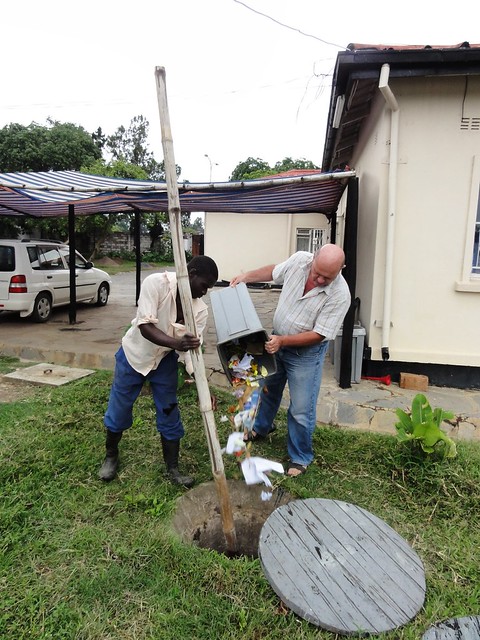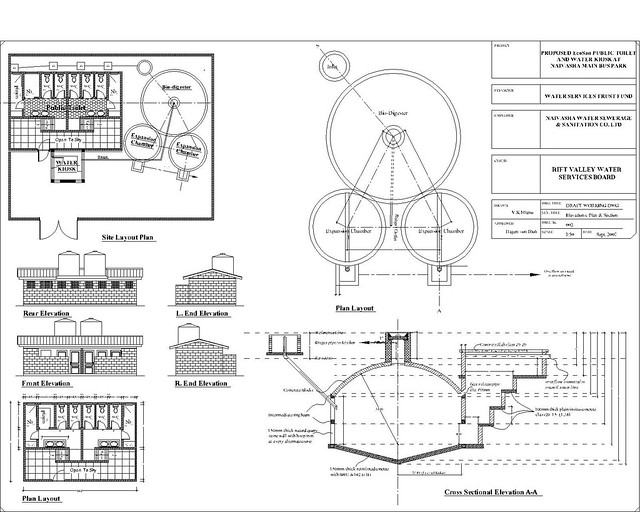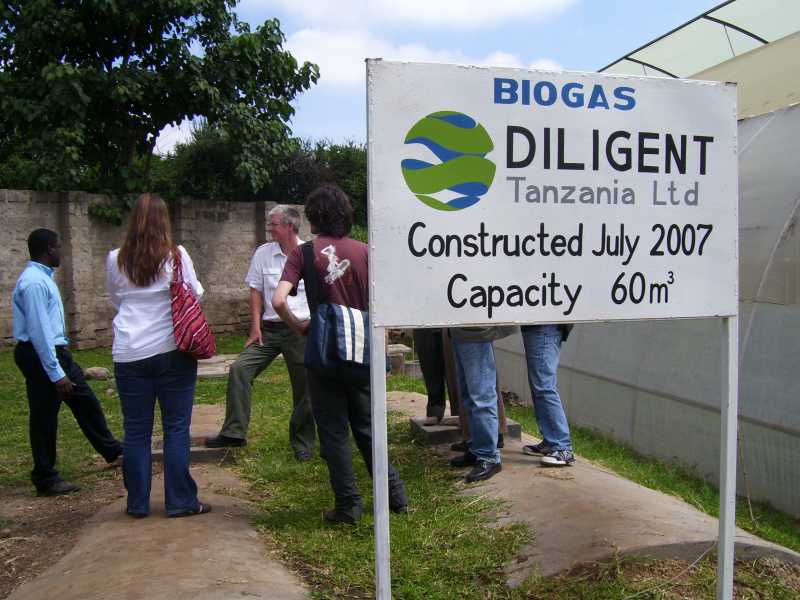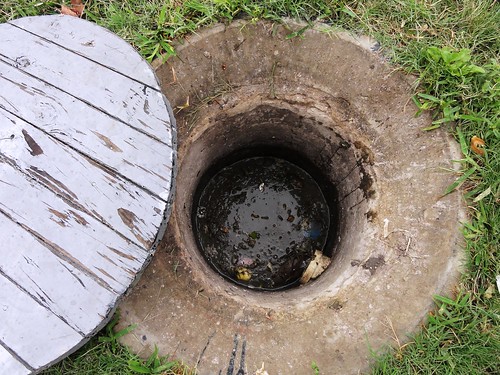- Forum
- categories
- Sanitation systems
- Treatment of wastewater, sludges, organic waste, excreta
- Anaerobic treatment systems (biogas sanitation)
- Biogas sanitation (systems focusing on biogas production)
- Toilets with a biogas/anaerobic digester
Toilets with a biogas/anaerobic digester
19.1k views
Hi Deo,Neal and Christian
Just wanted to point out that biodigesters are all the rage here in Kenya.
Some interesting articles on this topic were contributed for the Africa Water & Sanitation Nov-Dec 2011 edition by Mbugua Njoroge formally of the Athi Water Services Board,Nairobi-Kenya entitled ‘Bio Centres Take Shape in the Informal Settlements’ and another one in the same issue by Eng.Sam Mbugua entitled ‘Integrated Faecal Sludge Management into Urban Sanitation Planning’ .He remarked that this was ‘A reflection on Athi Water Services Board’s Participation at the 3rd AfricaSan Conference in Kigali,Rwanda.” Not to be left behind Dan Owino ( Lake Victoria North Water Services Board of Kakamega-Kenya) in the same issue wrote on ‘ LVNWSB scaling up Sanitation Services Provision.’ These articles carried thematic issues on Ecological Sanitation.Pls visit www.afriwater.org/publications
More recently Doreen Mbalo and Cees Lafeber carried an article on ‘Up-scaling Basic Sanitation for the Urban Poor in Kenya’ (Africa Water, Sanitation & Hygiene Sept-Oct 2012 edition).This is a 5 year programme by GIZ,KfW and Bill & the Melinda Gates Foundation and implemented by the Water Services Trust Fund (WSTF) Nairobi ,Kenya. Pls visit www.ubsup.go.ke/ for further information on UBSUP.
Christian,please compare & contrast and give your expert opinion on the differences between the images in the articles mentioned afore and the Tanzanian pixes and what you make of them.
Probably others who missed these articles may have a look and post a comment on the main issue,that is "Toilets with a biogas/anaerobic digester" .
Thanking you
S.Mwaniki
Just wanted to point out that biodigesters are all the rage here in Kenya.
Some interesting articles on this topic were contributed for the Africa Water & Sanitation Nov-Dec 2011 edition by Mbugua Njoroge formally of the Athi Water Services Board,Nairobi-Kenya entitled ‘Bio Centres Take Shape in the Informal Settlements’ and another one in the same issue by Eng.Sam Mbugua entitled ‘Integrated Faecal Sludge Management into Urban Sanitation Planning’ .He remarked that this was ‘A reflection on Athi Water Services Board’s Participation at the 3rd AfricaSan Conference in Kigali,Rwanda.” Not to be left behind Dan Owino ( Lake Victoria North Water Services Board of Kakamega-Kenya) in the same issue wrote on ‘ LVNWSB scaling up Sanitation Services Provision.’ These articles carried thematic issues on Ecological Sanitation.Pls visit www.afriwater.org/publications
More recently Doreen Mbalo and Cees Lafeber carried an article on ‘Up-scaling Basic Sanitation for the Urban Poor in Kenya’ (Africa Water, Sanitation & Hygiene Sept-Oct 2012 edition).This is a 5 year programme by GIZ,KfW and Bill & the Melinda Gates Foundation and implemented by the Water Services Trust Fund (WSTF) Nairobi ,Kenya. Pls visit www.ubsup.go.ke/ for further information on UBSUP.
Christian,please compare & contrast and give your expert opinion on the differences between the images in the articles mentioned afore and the Tanzanian pixes and what you make of them.
Probably others who missed these articles may have a look and post a comment on the main issue,that is "Toilets with a biogas/anaerobic digester" .
Thanking you
S.Mwaniki
Am the publisher of the Africa Water,Sanitation & Hygiene and the C.E.O. of Transworld Publishers Ltd.,Nairobi-Kenya.
Please Log in to join the conversation.
You need to login to reply- CAGIEA
-
 Less
Less- Posts: 29
- Likes received: 4
Dear Christine,
I would like to know more about this type of toilet, kindly give the contact for consult Kombe.
Thanks
Deo
CAGIEA
This email address is being protected from spambots. You need JavaScript enabled to view it.
I would like to know more about this type of toilet, kindly give the contact for consult Kombe.
Thanks
Deo
CAGIEA
This email address is being protected from spambots. You need JavaScript enabled to view it.
Please Log in to join the conversation.
You need to login to reply- christian.rieck
-

- Moderator
Less- Posts: 118
- Karma: 7
- Likes received: 41
Dear Neal,
I would suggest to have a separate feeding chamber for the fruit waste since you do not want to expose yourself to toilet waste water when feeding the waste to the digester. As Nanchoz has explained about one inlet chamber, I would not take much to fix such a separate feeding chamber to this inlet chamber.
I have seen a setup of toilet, fruit waste and digester in Tanzania in a Jartropha oil company that used the press cake to feed a digester which was also connected to a toilet block. I am however not sure how the feed in the press cake. See some pictures attached of the inlet chamber for the toilet waste water and the toilet building.
You would need to contact the consultant Kombe whose contact I could give you.
Cheers
Christian
I would suggest to have a separate feeding chamber for the fruit waste since you do not want to expose yourself to toilet waste water when feeding the waste to the digester. As Nanchoz has explained about one inlet chamber, I would not take much to fix such a separate feeding chamber to this inlet chamber.
I have seen a setup of toilet, fruit waste and digester in Tanzania in a Jartropha oil company that used the press cake to feed a digester which was also connected to a toilet block. I am however not sure how the feed in the press cake. See some pictures attached of the inlet chamber for the toilet waste water and the toilet building.
You would need to contact the consultant Kombe whose contact I could give you.
Cheers
Christian
GIZ Uganda
Enhanced Water Security and Sanitation (ENWASS)
Sanitation for Millions
This email address is being protected from spambots. You need JavaScript enabled to view it.
Enhanced Water Security and Sanitation (ENWASS)
Sanitation for Millions
This email address is being protected from spambots. You need JavaScript enabled to view it.
Please Log in to join the conversation.
You need to login to reply
Dear Neil,
as Elisabeth already mentioned is WASAZA (Lusaka, Zambia) running a quite well working biogas plant. Pretty interesting is that the inlet is made of concrete and connected directly to the dome. That means the inlet is ending up directly in the main dome. The toilets are connected by PVC pipe. You can see it on this picture:
What are you planning to do with the liquid effluent?
Cheers,
Philipp
as Elisabeth already mentioned is WASAZA (Lusaka, Zambia) running a quite well working biogas plant. Pretty interesting is that the inlet is made of concrete and connected directly to the dome. That means the inlet is ending up directly in the main dome. The toilets are connected by PVC pipe. You can see it on this picture:
What are you planning to do with the liquid effluent?
Cheers,
Philipp
Deutsche Gesellschaft für Internationale Zusammenarbeit (GIZ) GmbH
Please Log in to join the conversation.
You need to login to reply- Nanchoz
-
 Less
Less- Posts: 4
- Likes received: 0
Dear Neil
Here a few information concerning conection of the pipes from the toilets to the digester:
- route the 3 pipes from the toilet cubicles into one "inlet chamber" and from there with one pipe into the digester. With this you minimize possible leakage problems in the are of pipe-wall connection.
- if available take 4" pvc pipes (4 or 6kg/cm2) from the toilte cubicles to the inlet chamber. Give a slope of 1%.
- If available take a 6" (or 4") pvc pipe from the inlet chamber into the digester.
- make the pipe inlet into the digester below the waterlevel in the digester to prevent gas leakage.
See the drawing attached.
To give you more detailed input I need to see your detail design and the assumed input values.
Let me know if you need more.
Best Wishes
Nanchoz Zimmermann
Here a few information concerning conection of the pipes from the toilets to the digester:
- route the 3 pipes from the toilet cubicles into one "inlet chamber" and from there with one pipe into the digester. With this you minimize possible leakage problems in the are of pipe-wall connection.
- if available take 4" pvc pipes (4 or 6kg/cm2) from the toilte cubicles to the inlet chamber. Give a slope of 1%.
- If available take a 6" (or 4") pvc pipe from the inlet chamber into the digester.
- make the pipe inlet into the digester below the waterlevel in the digester to prevent gas leakage.
See the drawing attached.
To give you more detailed input I need to see your detail design and the assumed input values.
Let me know if you need more.
Best Wishes
Nanchoz Zimmermann
This message has an attachment file.
Please log in or register to see it.
Please Log in to join the conversation.
You need to login to reply- Elisabeth
-
- User is blocked
- Freelance consultant since 2012
Less- Posts: 3372
- Karma: 54
- Likes received: 932
Re: Toilets with a biogas/anaerobic digester
Dear Neal,
Welcome to the forum! From your posting I gather that you have already thought about all the different aspects of biogas sanitation. It sounds all very reasonably to me what you are planning (if perhaps a bit complicated that you want to do composting and vermi-composting of the slurry afterwards). What would the digestate be used for exactly?
Where in Burkina Faso will this be? Do you have local expertise at hand, also for construction? This is so important. Who do you work for? How will you guarantee the longer-term maintenance?
Regarding other projects, you have probably already seen all the biogas case studies on the SuSanA website?
See: www.susana.org/case-studies, then filter on the right hand side by technology "biogas".
See also the other thread in the same category here on the forum where I started a conversation on biogas sanitation in Rwandan prisons (forum.susana.org/forum/categories/35-bio...n-in-rwandan-prisons). The system which you propose is very common in rural China, Nepal and India, and also quite well documented.
In the SuSanA library we have tried to compile all the important biogas documents: www.susana.org, then select on the right hand side "biogas" under technology.
Philipp Feiereisen recently added these photos from Zambia to our collection, they are from a household biogas plant (set up by Chris Kellner who works for WASAZA in Lusaka), very small project but interesting:
www.flickr.com/photos/gtzecosan/sets/72157628619437135/
For example:

Feeding and mixing of the biogas plant by Sustainable sanitation , on Flickr
And this photo is a drawing from a biogas reactor for a public toilet in Naivasha (see SuSanA case study above for details; clink on link below the photo to see more photos from the same set on flickr):

30.Naivasha EcoSan Biogas Public Toilet Drawing by Sustainable sanitation , on Flickr
Anyhow, most likely you are already aware of these publications.
So I look forward to your replies to my questions and more of an in-depth discussion.
Regards,
Elisabeth
Welcome to the forum! From your posting I gather that you have already thought about all the different aspects of biogas sanitation. It sounds all very reasonably to me what you are planning (if perhaps a bit complicated that you want to do composting and vermi-composting of the slurry afterwards). What would the digestate be used for exactly?
Where in Burkina Faso will this be? Do you have local expertise at hand, also for construction? This is so important. Who do you work for? How will you guarantee the longer-term maintenance?
Regarding other projects, you have probably already seen all the biogas case studies on the SuSanA website?
See: www.susana.org/case-studies, then filter on the right hand side by technology "biogas".
See also the other thread in the same category here on the forum where I started a conversation on biogas sanitation in Rwandan prisons (forum.susana.org/forum/categories/35-bio...n-in-rwandan-prisons). The system which you propose is very common in rural China, Nepal and India, and also quite well documented.
In the SuSanA library we have tried to compile all the important biogas documents: www.susana.org, then select on the right hand side "biogas" under technology.
Philipp Feiereisen recently added these photos from Zambia to our collection, they are from a household biogas plant (set up by Chris Kellner who works for WASAZA in Lusaka), very small project but interesting:
www.flickr.com/photos/gtzecosan/sets/72157628619437135/
For example:

Feeding and mixing of the biogas plant by Sustainable sanitation , on Flickr
And this photo is a drawing from a biogas reactor for a public toilet in Naivasha (see SuSanA case study above for details; clink on link below the photo to see more photos from the same set on flickr):

30.Naivasha EcoSan Biogas Public Toilet Drawing by Sustainable sanitation , on Flickr
Anyhow, most likely you are already aware of these publications.
So I look forward to your replies to my questions and more of an in-depth discussion.
Regards,
Elisabeth
Dr. Elisabeth von Muench
Freelance consultant on environmental and climate projects
Freelance consultant on environmental and climate projects
Please Log in to join the conversation.
You need to login to reply- nbfaso
-
Topic AuthorLess
- Posts: 3
- Likes received: 0
Toilets with a biogas/anaerobic digester
Dear all,
Hello to all members! I am new to this website and would like to ask some questions about biogas sanitation, and its potential suitability for the project I am undertaking.
I am a volunteer engineer working on a 20m3 fixed dome biogas digester in Burkina Faso. This digester is to be used primarily for treating organic waste from a fruit processing unit (peel, damaged fruit etc), however, we now intend to build a small toilet block (3 cubicles) which will also be connected to the digester.
The proposed design will see a small block of 3 cubicles each with a 1-2 litre pour-flush squat-type toilet (this is the standard toilet set-up in the region). The block is to be positioned beside the digester.
I would be very interested to find out about any projects in with a similar set-up to this, particularly the low-volume pour-flush element and the related technical challenges that this poses for connection to a single inlet pipe in the biogas dome. The low-volume flush requirement is to ensure a maximum retention time in the digester of +60 days, avoid washout, ensure an optimum liquid-solids ratio and also to minimise water usage. The toilet is not intended as a public-use facility but for providing sanitation in small food processing units predominantly run as women's associations.
Of course this also leads to the question of treatment of the biogas slurry once a toilet is connected. I am aware that without thermophilic treatment (+50C in the biogas digester) that pathogens remaining in the slurry may pose a potential health hazard. It is proposed that the output slurry from our digester will be first composted with dry vegetable matter and subsequently vermicomposted to produce a better quality fertilizer. My main point of interest is explore the realities of any health implications for this process and whether these could seriously affect the viability of the project. In terms of quantities, the toilets will provide a small volume of human waste (around 10-20%) compared with the volume of organic fruit/vegetable waste being fed into the digester on a daily basis.
I am keen to open a discussion on the topics I have described and any feedback or specific resources/contacts that I could be directed to would be very gratefully received.
Kind regards
Neil
Hello to all members! I am new to this website and would like to ask some questions about biogas sanitation, and its potential suitability for the project I am undertaking.
I am a volunteer engineer working on a 20m3 fixed dome biogas digester in Burkina Faso. This digester is to be used primarily for treating organic waste from a fruit processing unit (peel, damaged fruit etc), however, we now intend to build a small toilet block (3 cubicles) which will also be connected to the digester.
The proposed design will see a small block of 3 cubicles each with a 1-2 litre pour-flush squat-type toilet (this is the standard toilet set-up in the region). The block is to be positioned beside the digester.
I would be very interested to find out about any projects in with a similar set-up to this, particularly the low-volume pour-flush element and the related technical challenges that this poses for connection to a single inlet pipe in the biogas dome. The low-volume flush requirement is to ensure a maximum retention time in the digester of +60 days, avoid washout, ensure an optimum liquid-solids ratio and also to minimise water usage. The toilet is not intended as a public-use facility but for providing sanitation in small food processing units predominantly run as women's associations.
Of course this also leads to the question of treatment of the biogas slurry once a toilet is connected. I am aware that without thermophilic treatment (+50C in the biogas digester) that pathogens remaining in the slurry may pose a potential health hazard. It is proposed that the output slurry from our digester will be first composted with dry vegetable matter and subsequently vermicomposted to produce a better quality fertilizer. My main point of interest is explore the realities of any health implications for this process and whether these could seriously affect the viability of the project. In terms of quantities, the toilets will provide a small volume of human waste (around 10-20%) compared with the volume of organic fruit/vegetable waste being fed into the digester on a daily basis.
I am keen to open a discussion on the topics I have described and any feedback or specific resources/contacts that I could be directed to would be very gratefully received.
Kind regards
Neil
Please Log in to join the conversation.
You need to login to reply
Share this thread:
- Forum
- categories
- Sanitation systems
- Treatment of wastewater, sludges, organic waste, excreta
- Anaerobic treatment systems (biogas sanitation)
- Biogas sanitation (systems focusing on biogas production)
- Toilets with a biogas/anaerobic digester
Recently active users. Who else has been active?
Time to create page: 0.175 seconds











